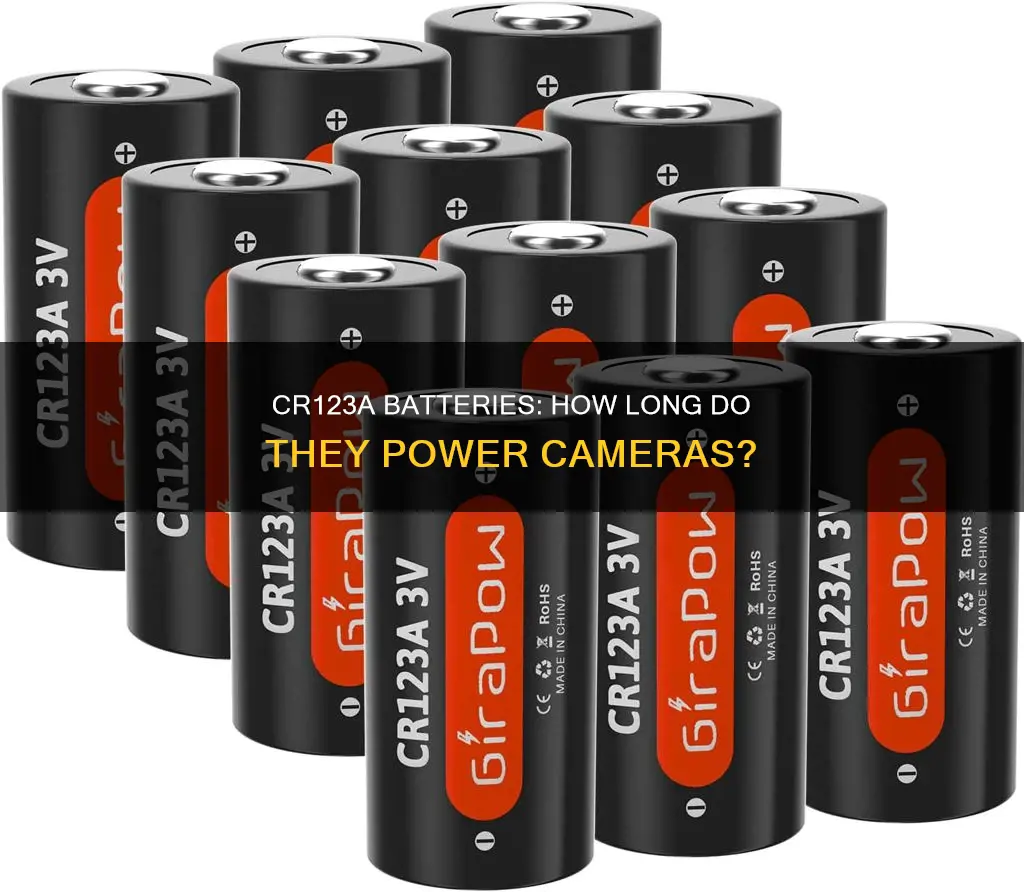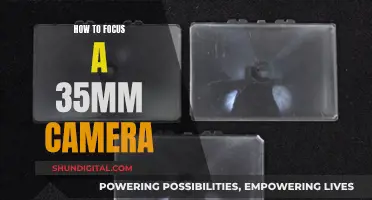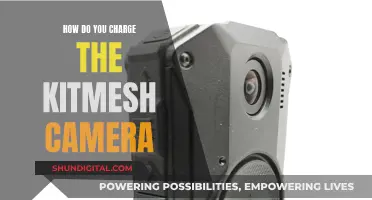
CR123A batteries are lithium-based batteries that are commonly used in small, high-output devices like cameras, flashlights, and smart home devices. They are known for their high voltage, energy density, durability, and stable operation. The lifespan of a CR123A battery depends on its usage and the device it powers. In a high-power device like a soldier's weapon light, it may last less than a month. However, in a passive device like a home security alarm panel, it can last over a year. CR123A batteries typically have a shelf life of up to 10 years and offer a capacity of around 1500 mAh. When used in cameras, they can last for about a dozen rolls with flash and even more without.
| Characteristics | Values |
|---|---|
| Typical Voltage | 3V |
| Typical Capacity | 1470-1600 mAh |
| Typical Height | 33.4mm |
| Typical Diameter | 17mm |
| Typical Weight | 17g |
| Lifespan | 3-5 years |
| Shelf Life | Up to 10 years |
What You'll Learn

CR123A batteries last up to 10 years in storage
CR123A batteries are small, high-powered lithium batteries. They are commonly used in cameras, flashlights, alarms, and other small electronic devices. They are cylindrical in shape, slightly shorter and fatter than AA batteries, and typically measure about 33.4 mm in length and 17 mm in diameter.
CR123A batteries have a long shelf life and can last up to 10 years when stored properly. This means that if they are not used and are kept in a cool, dry place, they can retain their charge for up to a decade. This makes them a convenient and reliable choice for devices that are not used frequently but still need to be ready to use at any time.
The exact lifespan of a CR123A battery depends on how often it is used and the type of device it is used in. In a high-drain device such as a soldier's weapon light, a CR123A battery may last less than a month. On the other hand, in a passive device such as a home security alarm panel, it can last over a year. In cameras, CR123A batteries typically last for several hundred shots, but this can vary depending on the camera model and usage patterns.
It is important to note that CR123A batteries are not rechargeable and should not be recharged as it can be hazardous. If you need rechargeable batteries, you can opt for batteries with similar dimensions but different chemistries, such as Lithium-Ion batteries.
Overall, CR123A batteries are a popular choice for many devices due to their small size, high power output, and long shelf life. When used in cameras, they provide reliable power and allow you to capture several hundred photos before needing to be replaced.
Charging Your ADT Doorbell Camera: Quick and Easy Steps
You may want to see also

CR123A batteries last 6-7 years with standard power output
CR123A batteries are small, high-powered lithium batteries. They are commonly used in devices such as cameras, flashlights, alarms, and other electronics. These batteries have a long lifespan and can typically be expected to last for up to 6-7 years with standard power output.
The exact lifespan of a CR123A battery depends on its usage and the device it powers. In a high-power device, such as a soldier's weapon light, a CR123A battery may last less than a month. On the other hand, in a passive device, such as a home security alarm panel, it can last for over a year.
CR123A batteries have a typical voltage of 3V and a capacity of around 1500 mAh. This capacity means that they can power a device drawing 100 mA for up to 30 hours. They have a shelf life of up to 10 years, even without use, and can be safely stored for long periods without significant degradation.
When selecting CR123A batteries, it is important to choose lithium batteries, which offer the longest lifespan. Alkaline batteries, for example, generally provide a shorter useful life. Additionally, it is recommended to choose well-known and trusted brands, such as Panasonic, Duracell, or Energizer, to ensure reliability and performance.
In summary, CR123A batteries are long-lasting and reliable power sources for various electronic devices. With standard power output, they can be expected to last for 6-7 years, making them a cost-effective and convenient choice for cameras and other electronics.
Troubleshooting Guide: Lumix Camera Battery Won't Charge
You may want to see also

CR123A batteries are interchangeable with other battery types
CR123A batteries are 3-volt lithium-based batteries that are commonly used in small, high-output devices such as cameras, flashlights, and alarm systems. While CR123A batteries are not rechargeable, their interchangeable counterparts, 16340 batteries, can be recharged and fit into the same devices.
CR123A batteries are often compared to CR123 batteries, which are also 3-volt lithium-based batteries used for similar applications. The main difference between the two is that CR123 batteries are typically longer and thinner than CR123A batteries. However, the difference in dimensions is usually negligible, and both types of batteries can be used interchangeably in most devices.
It's important to note that CR123A batteries are not the same as CR2 batteries, which are shorter in length and incompatible with devices that require CR123A batteries.
When purchasing CR123A batteries, it's recommended to choose reputable brands such as Panasonic, Duracell, Energizer, or Tenergy to ensure quality and authenticity.
Charging the Argus 2: How Long to Wait?
You may want to see also

CR123A batteries are not rechargeable
Although CR123A batteries cannot be recharged, there are rechargeable batteries with the exact same dimensions. For example, the 16340 battery is the same size and shape as the CR123A but is made of lithium-ion and is rechargeable.
The lifespan of a CR123A battery depends on its manufacturing quality and application. In a device that requires large amounts of energy, such as a soldier's weapon light, a CR123A battery may last less than a month. In contrast, with more passive usage, such as in a home security alarm panel, a CR123A battery can last over a year. In an alarm system, CR123A batteries can last up to five years.
When selecting batteries for alarm sensors, lithium batteries are recommended over alkaline batteries as they provide a longer lifespan. Additionally, some cameras that use CR123A batteries may continue to drain the battery even when turned off. This can be due to various factors, such as the camera never truly turning off and requiring power to keep the clock running.
Charging Camera Batteries: Strategies for Dead Rising Players
You may want to see also

CR123A batteries are ideal for high-power devices
CR123A batteries are cylindrical cell batteries with lithium chemistry. They are about 33.4mm long and 17mm in diameter, weighing approximately 17 grams. They have a nominal voltage of 3 volts and a capacity of 1470-2500mAh. This means that they can power a device drawing 100mA for up to 30 hours.
The lifespan of a CR123A battery depends on its usage and the device it is used in. In a high-power device such as a soldier's weapon light, it may last less than a month. On the other hand, in a passive device such as a home security alarm panel, it can last over a year. In an alarm system, CR123A batteries can last up to five years.
CR123A batteries are widely used in various applications, from medical devices to military-grade technology, making them very popular. They are produced by many large and small brands, including Panasonic, Duracell, Energizer, and Tenergy.
It is worth noting that CR123A batteries are not rechargeable. Attempting to recharge them can be hazardous as they may rapidly combust, causing damage to the device, charger, or user.
Charging Your Fujifilm Camera: A Step-by-Step Guide
You may want to see also
Frequently asked questions
The lifespan of CR123A batteries in a camera depends on the camera's power requirements and usage frequency. In a frequently used camera with high power demands, a CR123A battery may last less than a month. In a passive device, such as a home security alarm panel, it can last over a year.
On average, CR123A batteries offer a lifespan of three to five years. They typically have a shelf life of up to 10 years, retaining 90% of their capacity even after a decade.
The lifespan of CR123A batteries in a camera is influenced by the camera's power requirements, usage frequency, and environmental conditions. Cameras with high-power demands, such as those with flash or autofocus features, will drain the batteries faster. Additionally, frequent use and extreme temperatures can shorten battery life.







